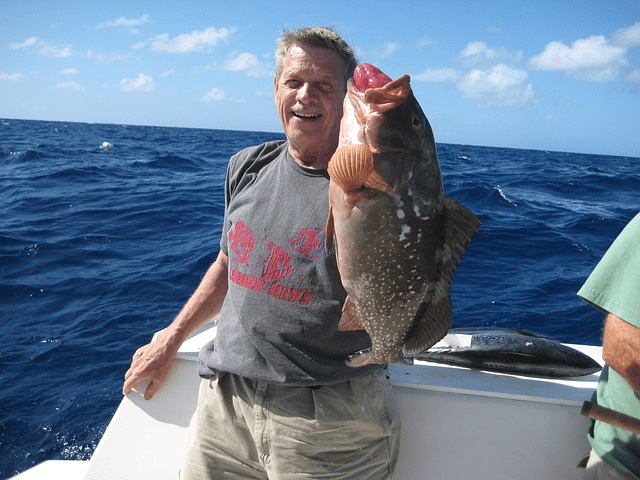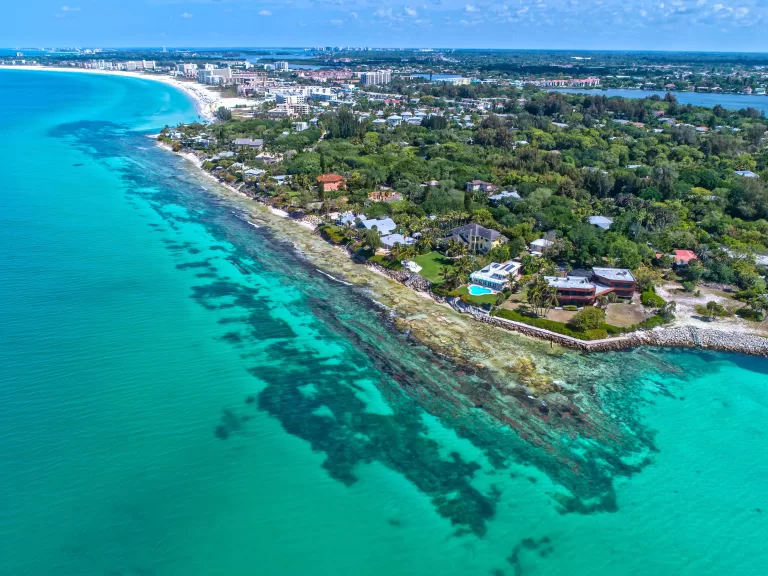The Ultimate Guide to Siesta Key Fishing: What Species To Catch, Where To Catch Them, and How To Do It
Sitting between Tampa and Fort Myers off Sarasota’s coast, the barrier island of Siesta Key is an angler’s paradise!
Living up to Florida’s typical beauty, Siesta Key has it all – from crystal clear waters to picturesque beaches to diverse fishing opportunities year-round. The island’s bays, piers, parks, and creeks are brimming with over a thousand fish species, fulfilling just about every angler’s inshore and offshore bite target!
To boost your chances of a successful Siesta Key fishing experience, you need to get familiar with the area’s underwater inhabitants, where to find them, and how to lure them in.
In today’s guide, we’re diving into Siesta Key’s impressive range of fish species, top angling spots, and best fishing techniques to get you in on the action!
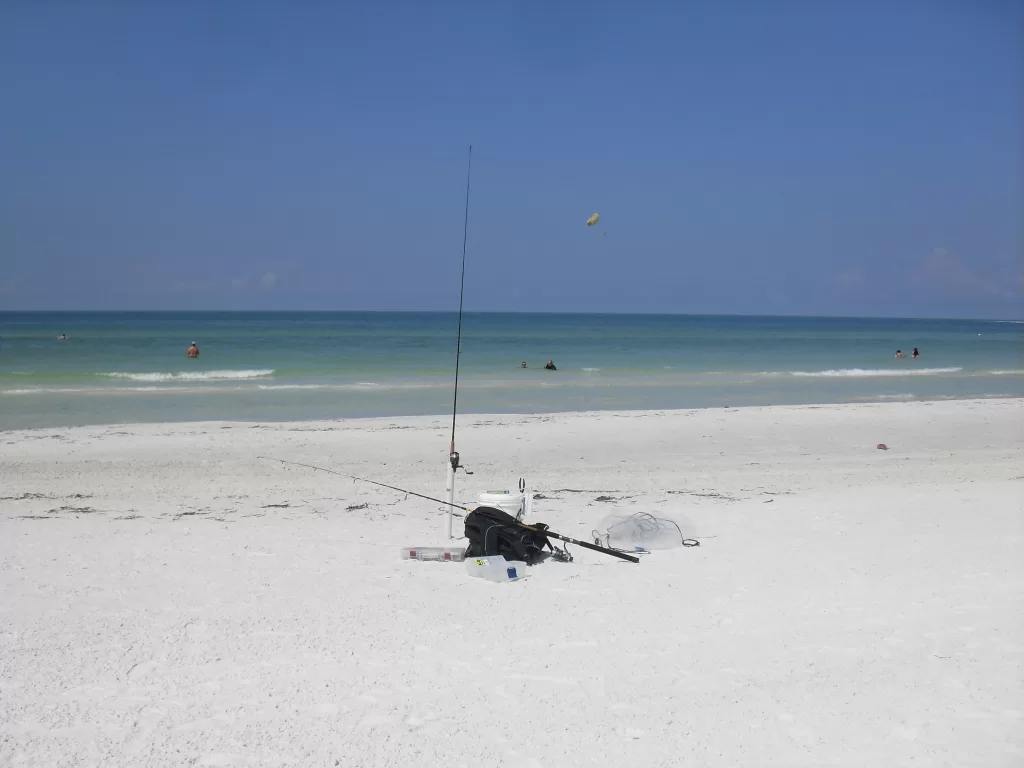
What Fish Species Can You Catch in Siesta Key?
We’ll kick off our Siesta Key fishing walkthrough with a list of the fish species to look out for while you’re there. There are hundreds of species in the waters of Siesta Key, we’re talking about the most notable ones:

Tarpon
Getting straight to big-game angling, Tarpon is present in Siesta Key from early May to late September. The yearly spawning run takes them just off of the island’s beaches around inlets and bridges. In the cooler months, they can be caught in the intercoastal waterways.
Strictly catch-and-release, this species prefers bait fish or live bait (crabs), but artificial lures can also give good results.
Snook
One of Siesta Key’s most popular catches, Snook is a challenge that you can take on from March until late November, although your best chances are during the summer.
Snook hang out in shallow waters around structures and shorelines. Incoming tides make a great opportunity for snagging Snook but keep in mind they’re a catch-and-release species.
Speckled Trout
Another popular catch in Siesta Key is Speckled Trout, available year-round for anglers. Their aggression is just enough to make catching them a fun activity, suitable even for beginners and kids.
Speckled Trout lingers in deeper grass flats and will bite on shrimp or live bait fish.
Redfish
A year-round resident of Siesta Key waters, your chances of catching Redfish are particularly high between late summer and early fall under docks and around shallow flats.
Reds spook easily though, so you need to be extra silent as you attempt to lure them with soft plastic bait, live fish, shrimp, or sardines.
Bluefish
If you fish in northern areas, you’re probably familiar with Bluefish. You’ll find these in the southern waters of Siesta Key, although smaller in size.
Presenting a fun challenge, Bluefish greedily bite on artificial bait if you don’t use live lures.
Sheepshead
Appearing in Siesta Key waters around late December and sticking around until early spring, Sheepshead is a bottom-dwelling species. They prefer depth and rocky structures with active current flow.
Your best bet to catch this fish is to use live lures such as shrimp and crab near wrecks, seawalls, docks, rocks, or bridges.
Black Drum
This tasty Redfish cousin is a sucker for live bait as their diet consists mainly of crustaceans.
Your best shot to snag this species is during winter months when the temperatures are low. Not only do they look similar to Sheepshead, but they even dwell in the same places!
False Albacore
A prized game fish of Siesta Key, Bonito –as locals call it– prefers staying inshore and feeding close to the surface. They don’t make the best meal, but they’re an engaging challenge with their fussy nature.
False Albacore will get hooked by small lures that resemble tiny fish.
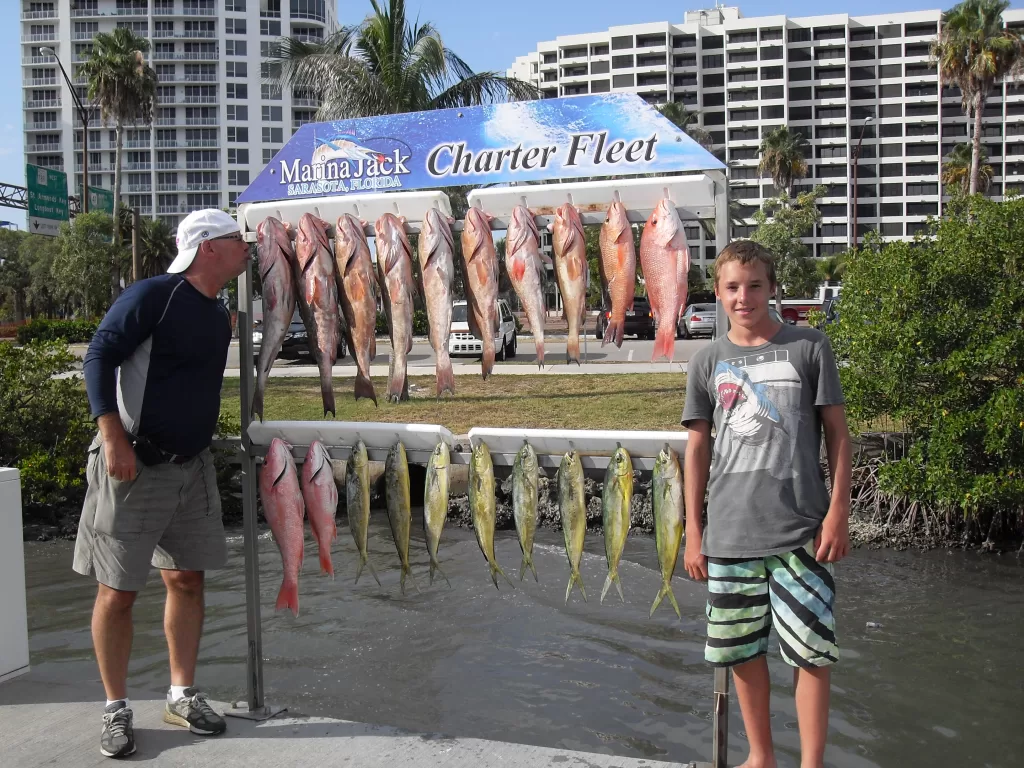
Grouper
You can come across Grouper when fishing inshore as well as offshore, especially near structures like bridges, rocks, and docks. You can use live or artificial lures to get a bite.
Crevalle Jack
Known for their speed and aggression, Crevalle Jack will put on quite the fight if you attempt to reel them in.
Growing as large as 15 pounds, their surface eating habits can be a good way to secure a bite. Use artificial baits such as jugs and spoons or live lures combined with a trolling technique.
Snapper
This popular fish is pretty feisty, but many anglers are happy to go through the trouble for a taste of its delicious flesh.
Snapper prefers sites with structures and will get hooked by live bait or shrimp. Your best bet to catch them is during summer.
Spanish Mackerel
This species will grace the Siesta Key waters during spring through fall and sometimes even summer. They’re often lingering on the surface –feeding– out on the beaches and will be lured in by any sort of bait. (read more about Spanish Mackerel here)
King Mackerel
While they’re mostly caught offshore, you can find King Mackerel inshore attracted by schools of bait fish brought closer to land by east winds. Your best bet to catch one is by trolling during spring and fall using a sizable live lure. (read more about King Mackerel here)
Ladyfish
This species dwells in deep grass flats and passes, effectively drawn to erratic baits.
Although they’re one or two pounds heavy on average, they can be quite difficult to reel in. So, if you’re looking for some action, Ladyfish will give you plenty!
Flounder
Yes, you can catch Flounder in Siesta Key, but the timing can be tricky to pinpoint.
We recommend looking for them in open grass flats and around structures, using live or artificial bait to lure them from near the bottom.
What Are the Best Spots for Siesta Key Fishing?
Siesta Key is riddled with good spots for anglers to practice their favorite activity, but some are better than others depending on the time of year. Here are the top fishing spots in Siesta Key:
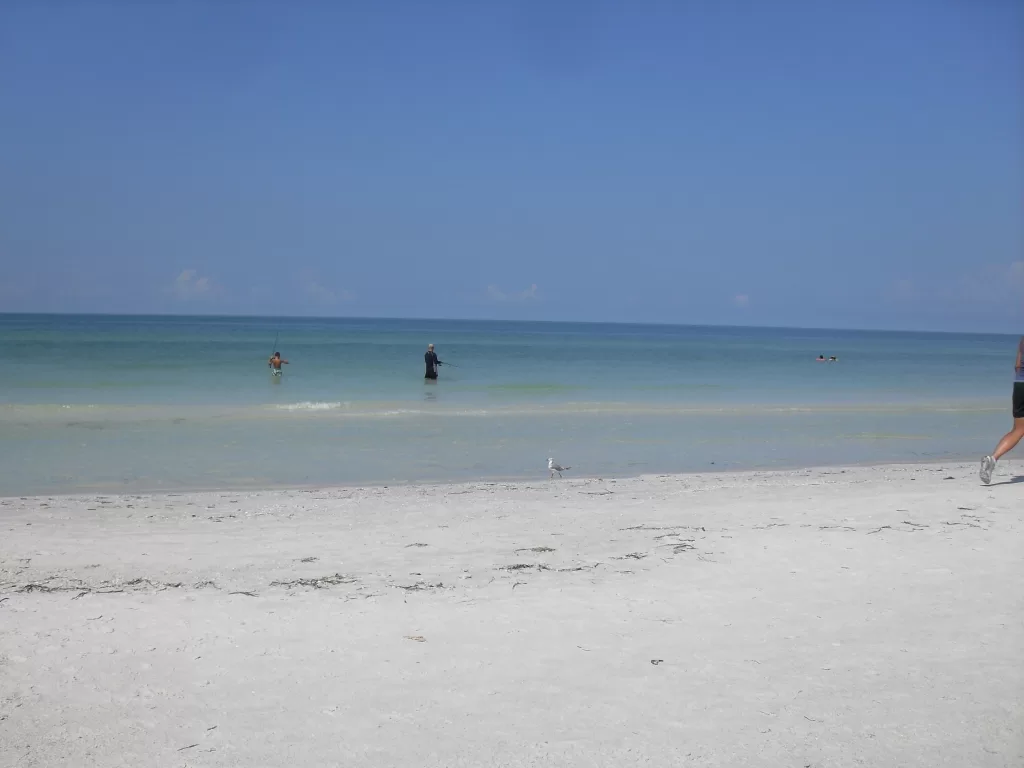
Point of Rocks
This is a popular destination for anglers on the Siesta Key side of the Gulf of Mexico.
Point of Rocks has plenty of structures that house bait fish, and so, attract game species such as False Albacore and Spanish Mackerel. This spot is public, so parking inside the neighborhood isn’t allowed.
Little Sarasota Bay
Crevalle Jack, Speckled Trout, Redfish, and Snook are some of the fish you’ll encounter in the grass beds at Little Sarasota Bay. The grass flats in this boater area offer fishing opportunities for Ladyfish, Pompano, and Trout.
Old Midnight Pass
We recommend this spot for anglers on the more experienced side who would appreciate a challenge.
Flounder, Kingfish, Cobia, and Grouper are among the species you can come across in Old Midnight Pass. It’s pretty close to Turtle Beach – just half a mile away!
Bay Island Park
If you’re looking for a convenient and diverse fishing spot, make sure to add Bay Island Park to your list of places to visit. With access to the Siesta Drive Bridge and the sea wall, you can find Trout, Ladyfish, Snook, Snapper, Pompano, and more!
It can get a bit crowded on the way there, but once you arrive, you can take advantage of the ample parking and portable restroom.
Blind Pass Lagoon
Situated beyond Turtle Beach at the southern edge of the island, Blind Pass Lagoon will certainly live up to most anglers’ expectations. It features piers, shores, and a seawall, with access to Little Sarasota Bay as well as the parking lot of Turtle Beach.
Turtle Beach
Whether you want to fish the backwater or the surf, Turtle Beach offers great angling opportunities when the waters are rough or calm. Snook is widely available in this spot, and you can enjoy a nice picnic on the boat ramp while you’re at it.
Big Sarasota Pass
You’ll find Shell Rd Park in this pass, offering a fun spot to catch Flounder, Spanish Mackerel, Snook, Ladyfish, Sheepshead, and more! Your best shot will be during the high tide, using live shrimp or artificial bait.
Siesta Key Beaches
These are terrific fishing sites when the waters are clear. Winter is ideal for Flounder, Trout, and Whiting fishing, while spring and fall are the seasons for Ladyfish, Mackerel, and Pompano targeting.
Phillippi Creek
If you’re planning your Siesta Key trip in cooler months, be sure to drop by Phillippi Creek. It doesn’t get much wind during winter, so you’ll be safe from harsh weather conditions.
There, you’ll have plenty of chances to catch Crevalle Jack and Snook in the creek and at its mouth. Rock ledges are also dwelling spots for Sheepshead and Snapper.
Siesta Drive Bridge
Head over to the area beneath the Siesta Drive Bridge for a fantastic chance to catch species attracted to structures such as Snapper and Grouper.
Connecting the mainland to the north part of Siesta Key, this bridge sits at the northern edge of the island and has plenty of parking spaces.
Stickney Point
If you enjoy shore fishing, you’ll appreciate this particular spot with its morning and evening tides. It features a wide array of targeting opportunities, including Snapper, Ladyfish, Sheepshead, Trout, Snook, Flounder, and Drum.
New Pass
Anglers aiming to practice their offshore fishing techniques will find lots of luck in this spot. Snapper and Grouper are among the species dwelling at the 40- to 80-foot depth available in New Pass.
Big Pass
This extended, narrow inlet is located at the northwest edge of Siesta Key, opening into the Gulf of Mexico and serving as a separation point between this island and Lido Key.
Featuring a rocky bottom, this spot is a wonderful site for fishing Grouper, Ladyfish, Snook, Flounder, Sheepshead, Snapper, and Crevalle Jack.
Roberts Bay
If you have access to a watercraft, Roberts Bay won’t disappoint. It features various structures and habitats that attract pretty much every species the island has to offer
What Are the Best Techniques To Use for Siesta Key Fishing?
Now that you’re familiar with the fish species in Siesta Keys and their whereabouts, let’s briefly discuss the best techniques you can use for fishing throughout this beautiful island.

Trolling
This method is popular among beginner and experienced anglers alike, allowing you to target various fish; including Bonito, Marlon, Kingfish, Spanish Mackerel, Mahi Mahi, and Tuna. It involves dragging your bait/lure at a certain speed depending on the species.
Bottom Fishing
Simple and beginner-friendly, this approach involves dropping bait to the bottom of the water and patiently waiting. It works well at structures such as coral reefs, piers, and rocks to produce Grouper, Snapper, Flounder, and more.
Sight Fishing
If you’re after species such as Redfish, Tarpon, and Snook, add this gentle-cast technique to your arsenal. The secret to success here is to pinpoint the right spot to cast, so clear water is a must.
Surf Fishing
Any time of the year is good for surf fishing in Siesta Key. Spots such as Turtle Beach, Big Pass, and Points of Rocks are especially lucrative for this technique.
Fly Fishing
Although not very common to see in Siesta Key, this technique may just be your secret weapon to snag Tarpon and Snook. Stick to the mangroves, the nearshore, and the shallows for fly fishing.
Drift Fishing
If you use live lures while drifting with the water current, you’re drift fishing. This method can be effective for landing Snapper, Cobia, Grouper, and Kingfish.
Summary
It’s evident by now how incredibly rich Siesta Key is when it comes to fish species and fishing sites.
This diversity makes it a fantastic destination for anglers, just make sure to plan your trip depending on the species you’re hoping to snag and leave the rest to this mesmerizing island!
Frequently Asked Questions
When Is the Best Time To Go Fishing in Siesta Key?
This depends on the species you’re targeting as different fish become active during varying times of the year. In general, however, we recommend the warm summertime.
Does Siesta Key Fishing Require a License?
If you’re 16 or older, you’ll need a Florida angling license to fish in Siesta Key.


